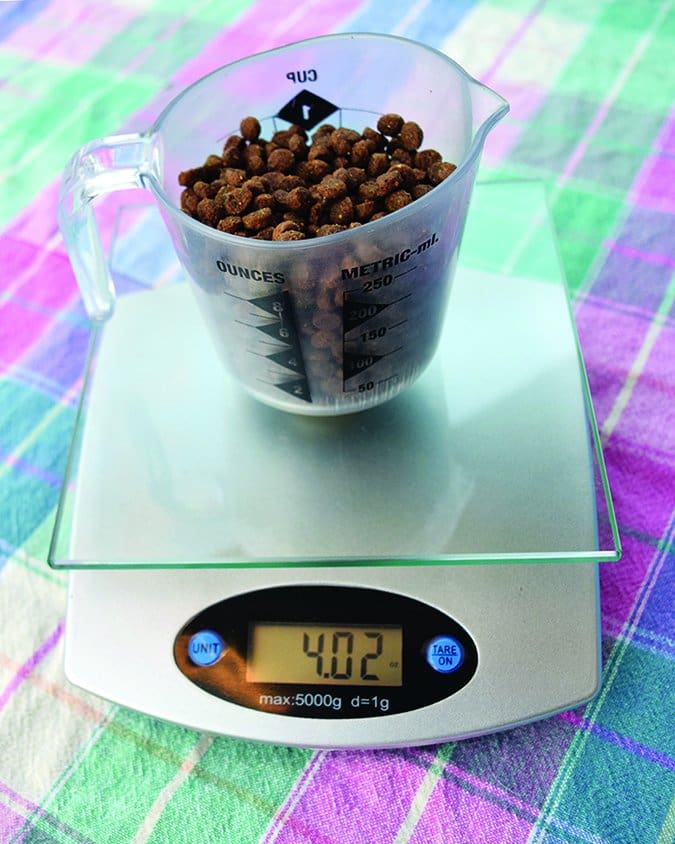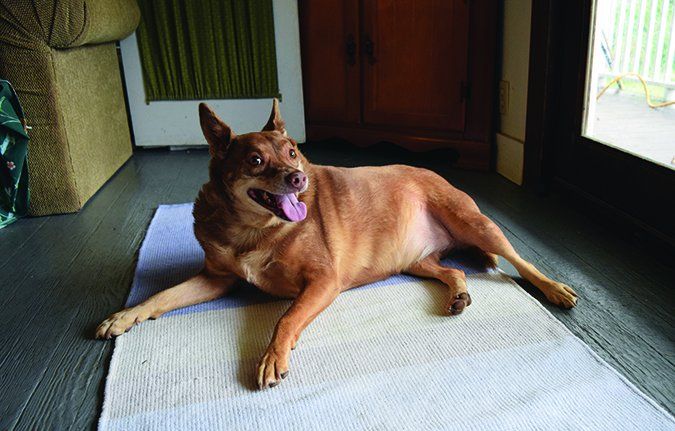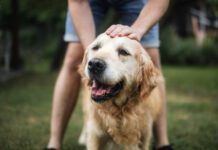Older dogs, like older people, have an easier time getting around if they aren’t overweight. Losing weight can be a challenge for dogs at any age, but more so as dogs grow older. Still, weight loss for dogs is worth the effort. Slender dogs not only get around more easily, but also actually live longer. A 14-year study showed that dogs fed 25 percent fewer calories than their free-fed littermates lived nearly two years longer, showed fewer visible signs of aging, and enjoyed an extra three years of pain-free mobility before developing canine arthritis. These weight loss tips for senior dogs can help them live a longer, healthier, happier life!
Health problems that are more common in overweight dogs include pancreatitis, diabetes, heart disease, disc disease, ruptured cruciate ligaments, hip dysplasia, other forms of joint disease, surgical complications, compromised immune systems, and several types of cancer. And sadly, studies show that more than half of America’s dogs are overweight – and nearly all of their owners are in denial! If you can’t easily feel your dog’s ribs and shoulder blades, if her waist is not discernable (a tuck behind the ribs), or if there’s a roll of fat at the base of her tail, it’s time to face reality and put your dog on a diet.
As WDJ contributor Mary Straus explains, “Because we’re so used to seeing overweight dogs, many folks think a dog at his proper weight is too skinny, but as long as the hips and spine are not protruding, and no more than the last rib or two are slightly visible, he’s not too thin. If in doubt, ask your vet for an opinion, or go to an agility competition to see what fit dogs look like.”
Here are 10 weight loss tips for senior dogs:
1. Feed your overweight dog more protein and less carbohydrates.
When it comes to weight loss, the ratio of carbohydrates to fats and protein matters more than calories do. Most prescription weight-loss diets are high in carbohydrates, low in fat, and low in protein, a combination that makes it difficult to lose weight. Dogs thrive on a high-protein diet, which builds lean muscle, and they don’t need carbohydrates at all. The ideal canine weight-loss diet is high in protein, low in carbohydrates, and moderate in fat, which satisfies the appetite.
2. Avoid feeding your dog high-fiber foods.
Increased fiber, the indigestible part of carbohydrates, will not help your dog feel satisfied, and too much can interfere with nutrient absorption. Grains are a common source of fiber, and many grain-free foods are high in protein and low in carbs, which can make them effective foods for weight loss (as long as they don’t contain too much fat).
3. Make your dog’s food.
Another option is to make your own high-protein, moderate-fat, low-carbohydrate diet (see “Easy Home-Prepared Dog Food,” WDJ July 2012, for guidelines).
“If you feed a homemade diet, use lean meats, low-fat dairy, and green vegetables in place of most grains and starches,” Straus suggests. “Remove the skin from poultry (except for breasts) and remove separable fat from meats. Avoid fatty meats such as lamb, pork, and high-fat beef, or cook them to remove most of the fat. It’s okay to include eggs in moderate amounts. You can also use these foods to replace up to 25 percent of a commercial pet food, which will increase the total amount of protein and decrease carbohydrates in the diet.
“There’s a common misconception that replacing a large portion of the diet with green beans will help your dog not feel hungry,” she adds. “While there’s no harm in adding some green beans or other non-starchy veggies to your dog’s diet, the extra bulk won’t help your dog feel satisfied if you’re feeding too few calories or too little fat. It is fat that most helps to satiate your dog; just adding bulk isn’t enough. Replacing too much food with green beans can also lead to a protein deficiency, causing the loss of lean muscle rather than fat.”
4. Feed your dog the right fats.
Recent human and canine studies show that the omega-3 fatty acids EPA and DHA from fish oil promote weight loss and help dieters feel more satisfied. Straus recommends giving fish oil that provides 1 to 1.5 mg combined EPA and DHA per pound of body weight daily for healthy dogs, or up to 3 mg for dogs with health problems (such as heart disease, kidney disease, cancer, arthritis, allergies, and other conditions causing inflammation or affecting the immune system). Some cod liver oils, such as Carlson Norwegian Cod Liver Oil with Omega 3s, provide vitamins D and A for additional health benefits (see “Vitamin D for Dogs,” WDJ July 2016).
When adding oils to your dog’s diet, keep in mind that oils are pure fat, adding more than 40 calories per teaspoon. Label directions for many liquid fish-oil products are higher than they should be, adding too many calories to your dog’s diet. If your dog needs high doses of EPA and DHA, look for more concentrated softgels. Other oils, such as coconut and olive oil, should be carefully measured to be sure you’re not adding too much fat.
5. Reduce your dog’s food portion size.
Instead of making drastic changes all at once, cut your dog’s food back by about five percent and feed that slightly smaller amount for a week or two. This reduction is about 1 ounce per pound or 1/8 cup per two cups of food. Weigh your dog today and again in one or two weeks. If she doesn’t lose weight, reduce the food by another five percent and continue at that amount for one to two weeks. Keep gradually reducing the amount of food until your dog begins to lose weight, then continue feeding that amount.
This strategy helps because reducing the amount of food too suddenly will change your dog’s metabolism, making it harder to lose weight and easier to gain it back. Slow, steady weight loss is more likely to result in long-term success.
If you switch to a food that’s considerably higher in protein and fat than your current food, cut the quantity by up to one-third, as foods that are more nutrient dense will provide more calories in smaller portions. Even though the total amount your dog receives is less than before, he may be more satisfied.

Feeding smaller portions more often will help your dog feel less hungry. Replace some dry food with canned or fresh, high-protein food so he thinks he’s getting something special. Put his meals in a Kong, Buster Cube, or other food-dispensing toy so he has to work for them, leaving him feeling more satisfied. Freeze his wet food, or dry food mixed with nonfat yogurt, in a Kong toy to make a meal last even longer.
6. Measure everything your dog eats.
“It’s critical to accurately measure your dog’s food,” says Straus. “I learned the hard way that when I try to eyeball my dogs’ food, they gain weight. The only way I’ve found to achieve consistent weight control is by using an electronic scale to weigh everything I feed. You can find scales at office and kitchen supply stores and online. Most handle up to five pounds with accuracy to one tenth of an ounce, and they can switch to grams for very small measurements.”
7. Make your dog’s weight loss a family project.
Measuring everything and writing it in your dog’s diet book or food log helps family members realize just how much the dog is eating. Feeding a small dinner won’t help if Fido is getting breakfast leftovers, afternoon snacks, and training treats all day. Discuss the diet plan with everyone who feeds your dog and get their cooperation. You can give each family member a specific number of small training treats to reward the dog with, and encourage everyone to focus on games, walks, playing fetch, and favorite activities as calorie-free rewards that will keep your dog motivated.
8. Weigh your dog.
If your dog is small, you can weigh her on a baby scale or a postal scale designed for packages. Your veterinary clinic has a walk-on scale that accommodates dogs of all sizes, so if your large dog is willing, take her there every one or two weeks. If your dog associates the clinic with unpleasant experiences, use low-calorie, high-value treats to help change her attitude. Most dogs respond well to short visits that include treats, eagerly hopping on the scale, and sitting or standing still for a minute before going home.
“Aim for weight loss of three to five percent of body weight per month, or one percent per week,” says Straus. “A 50-pound dog should lose about half a pound per week, or two pounds per month. Once your dog begins losing weight steadily, you can go longer between weigh-ins, but recheck monthly to make sure you’re still on track. It’s easy to slip back into giving too much food and not notice until your dog has gained back a lot of weight. Caloric needs can also change over time as your dog ages, after neutering, or if his activity level varies seasonally. If you’re weighing your dog regularly, you’ll be able to catch and correct any weight gain before you have a bigger problem.”
9. Rethink the treats you feed.
When Ella, her Norwich Terrier, gained weight even with reduced meals, Straus realized that she had to consider the calories Ella received from training treats. “I fed her cooked chicken breast to counter-condition her shyness around strangers that we met on our walks,” Straus says. “I put treats in a Kong toy when I had to leave her alone to reduce any anxiety she might feel about my leaving, and I used clicker training to improve my communication with Ella. Altogether, those treats were adding up to a lot of calories.”
Fortunately, dogs care more about the number of treats they receive than the size of each treat, so it’s more rewarding for a dog to receive several small treats than one big one. For a dog Ella’s size, Straus switched to really tiny treats. “I now use treats for nose work training, where I need high-value treats. I cut slices of turkey bacon (17.5 calories per slice) into 35 pieces that are just half a calorie each. Zukes Lil’ Links (16 calories each) are cut into 16 pieces, one calorie each. Happy Howie’s beef and turkey rolls have 52-60 calories per ounce and can be cut into small cubes of no more than one calorie each (note the lamb variety is much higher in calories). Slice treats in half or quarters lengthwise before dicing to create lots of small pieces.”
Treats that are high in fat and calories, such as hot dogs and peanut butter, can pack on the pounds. Instead, try raw baby carrots, zucchini slices, other crunchy vegetables, or small slices of apple, banana, or melon. Make your own treats out of low-fat organ meats like heart or liver. Grapes, raisins, and anything containing xylitol (a sugar substitute) should not be used, as they can be toxic to dogs.
Another strategy is to feed some of your dog’s dinner as treats during the day. Just be sure to reduce her meal size accordingly.
10. Find the right edible dog chew.
Dogs love to chew, and if you can find a low-fat, long-lasting chew, it can keep your dog busy, satisfied, and out of caloric trouble. Dried tendons, steer sticks, and similar chews work well unless they’re small enough for the dog to swallow.
If you use rawhide, WDJ recommends high-quality, thick, unbleached (not white) rawhides without added flavorings or smoking, made from one solid piece, and preferably made in the U.S., such as those from Wholesome Hide. See “Finding the Right Rawhide Chew for Your Dog,” WDJ May 2009, for information on healthy rawhide chews.
Fresh, raw bones can also be used for chewing, but Straus adds an important caveat, “Bones, like any hard chew, have the potential to break teeth, particularly in older dogs whose teeth are more brittle. Bones that are too big for dogs to get between their molars and chomp down on, such as knuckles, are less likely to cause problems than marrow bones, which are filled with fat and therefore not a good choice.”
Freelance writer CJ Puotinen is the author of The Encyclopedia of Natural Pet Care and other books.







Thank you for a great article on weight loss tips.I am in the. process of getting weight off my dog and this helped so much
Very helpful article. I am trying to find the right balance of foods for my foxy / lab X. ‘Tessa’ is about 7 years old and has been with us for 15 months now. Earlier life was spent producing babies with last delivery by cesarean section, followed closely by her being speyed before we could adopt her. She was somewhat malnourished and weighed just under 18kg. She has since put on weight to reach 22kg, but with increased exercised, has developed considerable muscle tone. Her past history is a blank to us, but I have recently stopped feeding her kibble. Her diet is now raw or freeze dried venison or possum (whole animal) with lots of green veggies. She has a tin of sardines once a week at least. I will have to start seriously weighing her food portions as I think she needs to be at least 1.5kg lighter. ‘John’ in NZ
What do I feed my dog she’s a German Shepard she’s over weight by 10 pounds and I’ve tried walking her and I only feed her once a day she is 7 years in human years I don’t know what to do
please check with your vet! or search facebook (if you belong), there are all kinds of groups that have so much information!
I fed my poodle Fat Dod Food. That’s what it is called. It’s for dogs and cats that are over weight. My vet turned me on to it . My poodle did lose weight and once she did I put her back on her regular dog Fios. You can continue to feed your dog Fat Dog Food for as long as you want. Can buy this a Petco or any pet store. Google it and you can read all about this food
Please reconsider that food. Research pea protein and beet pulp for fogs.
I have a chiwhawha who is overweight. Hes 3.62 kg but I’ve been told 3kg is heavy enough for him
I had him down to 3.5kg but hes put on 12 grams which I put down to giving him cooked carrot and less kibbles as hes such a hungry little fellow.
1. Does he need two meals a day he’s 8 years old
2. What can I give him as a filler.
I have a Chiwhawha mix with mini Ausie. Her weight has been an issue from the beginning. at first i thought so cute, but now it is out of control. I have tried a variety of methods and seems they are not working. I have to admit that in the beginning i was feeding her leftovers…well they set her on a path of expecting it. Her winning when she does not get her way is out of control. UGH!
So now she is 13 yrs of age and being that she is older…the weight has spiraled! I am at my wits end and need help!!
I can read and read….just give me what has worked for your small dogs! I want her around for another few years and living her best life! HELP??????
put her on a harness and walk her daily for about 10 to 20 minutes don’t make her run at first but start with walking. after she sees to be less tired during walks start doing slow jogs and then go to a run. make sure to go up hills and inclines every now and then to.
Awesome article, thank you so much! I will use several of your tip. The question I have is, my chaweinne gets the products from the cold section. How do I know if it is good for her? I started this to limit her carbs.
my small dog is ten years old and over weight and i would love for him to loose some weight. any tips on how to properly exersise him?
My dog is a figure so Bourdieu X has just turned 11 has hurt his back and is on predicalone which makes him hungry, he has stacked on the weight which doesn’t help him at all IV been making my own food for him using chicken or turkey mince , chicken livers, giblets,grated carrots,corn ,peas legumes /soup mix grains tumeric powder is there something I’m doing wrong or can U please advise me on what to do
My spaniel has an auto immune disease from interbreeding. She has been on cortisone since aged five as well as Atopica for the last three or four months. She is overweight from the meds. Can you advise me how to go about a feeding plan for her. Bella is now 1 year and five months old.
Hi! Puotinen, I just want to say thanks a lot to you for sharing these tips. Actually, I implement some of these before, with really impressive results…
My 10 year old dog is a small-dog who’s usually about 10-12 lbs but he is about 20-22 lbs at the moment. I have been thinking about switching him to a diet of only canned green-beans or peas. Does anyone know how to help my dog loose weight?
My mini dachshund is 14 1/2 yrs.
She has been tested for almost everything, and she’s fine. She’s on a diet because of vomiting. She has stopped vomiting. She eats well, but she weighs about 8lb normal she weighs around 11lbs. I am so worry about her. What should I do?
Can I feed my Shiba raw chicken with bones?
I have a 2 1/2 year old mix chihuahua he’s at 11 pounds, a couch potato and eats 2 times a day. 2 oz of soft food and at nite gets 1/4 of a cut of salmon kibble. In this food he’s gained this weight. He’s a rescue we’ve had for 2 years ( he was around 6-7 months old) and weighed 8.4 lbs when we got him. No big on a lot of fresh veggies. Help, what do I feed him and how much.
My dog is an older terrier mix and a rescue and the coolest dog I’ve ever had. Independent little cur.
He eats air-dried, human-grade food made specifically for dogs. Has a better nutrition profile than what I’m eating. However, I’m going to apply this same logic to my dog’s owner as well….. LOL